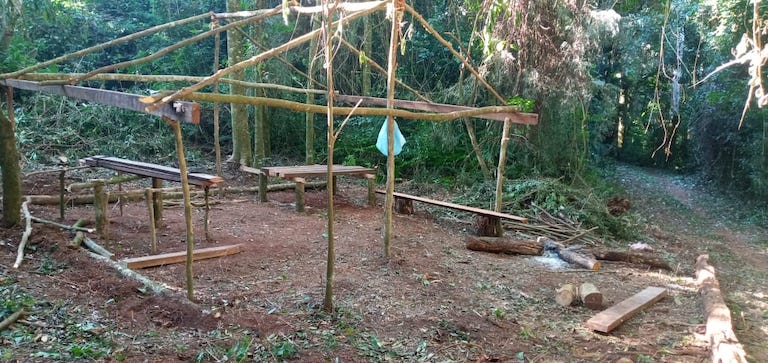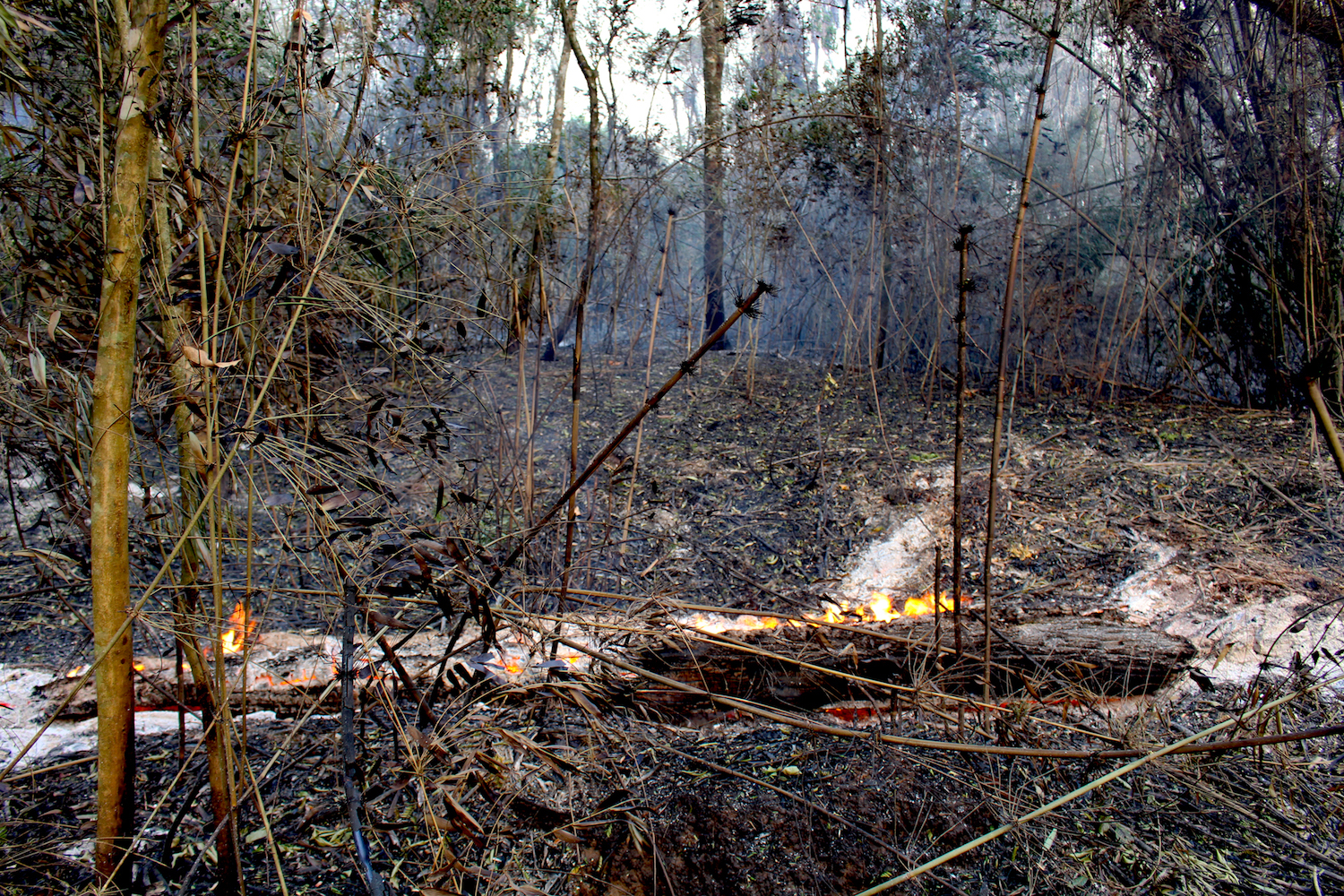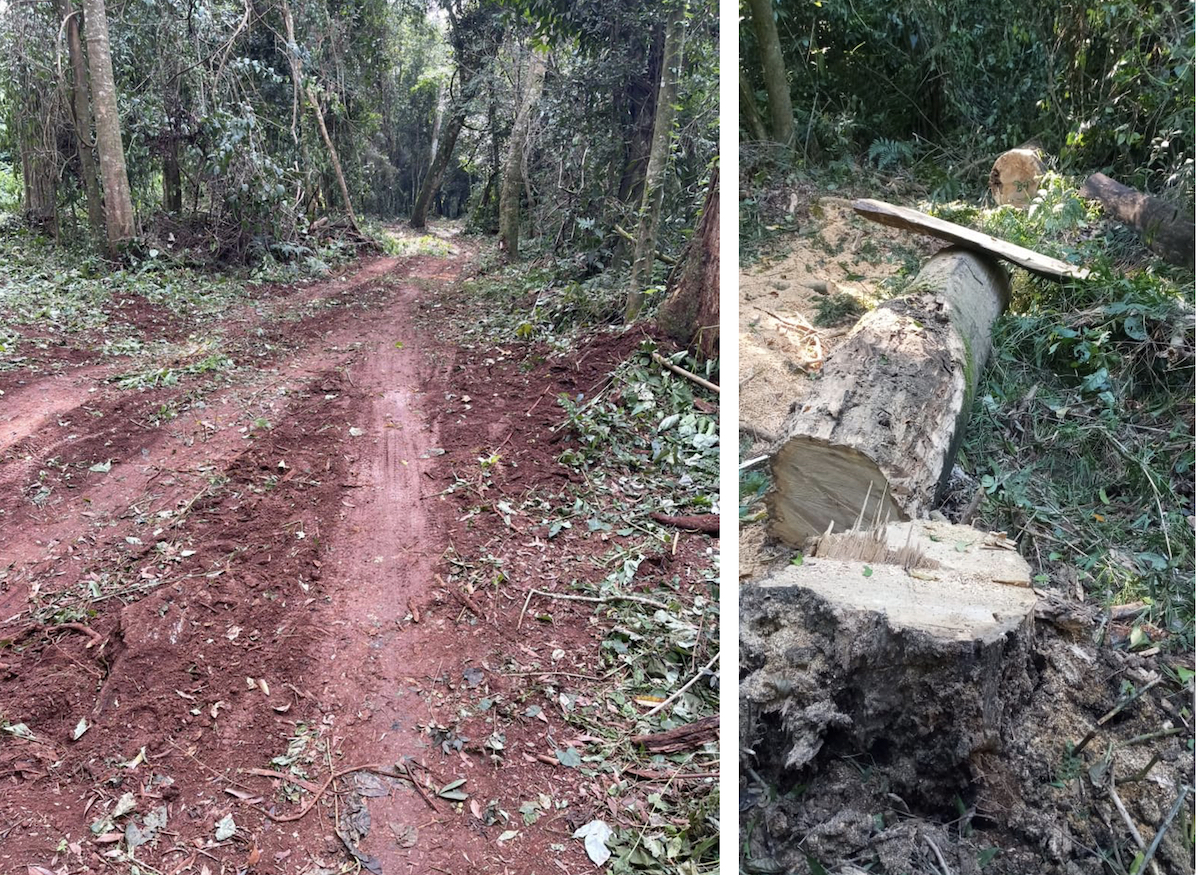- San Rafael National Park/Proposed National Reserve encompasses one of the most unique, biodiverse and threatened forests in Paraguay.
- Fires in late 2020 burned an estimated 45% of the reserve, and biologists say it may take decades for the area to recover.
- Meanwhile, drug traffickers are expanding illegal marijuana plantations within San Rafael and on May 21, more than a hundred outsiders reportedly crossed into the reserve where they are clearing trees and establishing settlements.
- Despite its international categorization as a national park, a 2002 recategorization error left San Rafael unrecognized as a protected area in Paraguay, making the area ineligible for proper protection.
San Rafael National Park/Proposed National Reserve sits in eastern Paraguay, quietly encompassing a remnant of the Upper Paraná Atlantic Forest, a unique biome that stretches between Brazil, Argentina and Paraguay and provides habitat to some 260 species of mammals and 940 species of birds. More than half of its plant species and 90% of its amphibians are endemic, meaning they’re found nowhere else in the world.
San Rafael’s portion alone boasts more than 435 bird species – 70 of which are endemic – along with 61 mammal, 82 reptile and amphibian and 52 fish species, according to Rebecca Smith, a primatologist and country director at Fundación Para La Tierra, who added that a lack of study of the area “means there is probably much more.”

In addition to supporting unique wildlife populations, San Rafael’s forests benefit the climate and nearby human communities as well.
“Studies in other areas of Atlantic Forest have shown that this habitat can store an average of 223.5 tons of carbon/hectare, therefore preserving the forest is also an important tool in the fight against climate change,” Smith said. “The forest also protects a recharge zone for the Guaraní Aquifer that provides drinking water for millions of people in South America.”
But this unique forest is swiftly disappearing as it’s gobbled up for timber and farmland, and razed by fire.
“The Upper Paraná Atlantic Forest (BAAPA) is one of the world’s most endangered terrestrial habitats,” Smith said. “This habitat once covered over 86,000km2 of eastern Paraguay but today 92% of this highly biodiverse forest has been cleared for industrial agriculture. What remains is extremely fragmented, often degraded and under intense pressure.”
The remnant contained in San Rafael has fared somewhat better over the years. That is until 2020, when devastating fires ripped through the region and burned nearly half of the reserve’s remaining forest.
More recently, on May 21, around 150 outsiders reportedly entered San Rafael and began illegally clearing trees, according to Smith who said she is in contact with a landowner who has been threatened by these new settlers and wishes to remain anonymous for safety reasons.


Smith said the outsiders moving into San Rafael are doing so to “cut trees and squat on the land, with the intention of being awarded a title deed.” Paraguay has a moratorium on deforestation, which makes this situation illegal. “However, the police and government very rarely help in such situations as they are understaffed, underfunded and unmotivated,” Smith said. “The situation reached a crisis point during the pandemic.”
According to Smith, the landowner was informed by the settlers that they are intending to clear thousands of hectares.
“The people who have entered the forest are aiming to clear 6000ha [14,800 acres] – this will be an absolutely devastating blow to the forest and it is also likely that the clearing will cut this largest remaining block of BAAPA in Paraguay into two fragments,” Smith said. “The loss of this forest will be a national, and international, tragedy.”
Devastating fires
The May incursion is just the latest in a litany of pressures threatening the future of San Rafael. In November 2020, massive fires engulfed the area. By the time they were finally extinguished in December, around 45% of the reserve had been burned.
“We had never had a record of this scale in terms of forest loss,” said Alicia Eisenkölbl, Executive Director of the organization Pro Cordillera San Rafael (PRO COSARA) and who has been helping manage the reserve for several years.

The fire coincided with a period of extreme drought that affected much of the country. No rain fell for nearly six months, a rare and devastating event for a region and ecosystems that depend on regular precipitation.
Eisenkölbl attributed the fires to a lack of humidity coupled with hot, dry air, and said last year’s event was likely the worst that’s occurred in San Rafael since PRO COSARA started working with fire records in 2005. According to PRO COSARA and MADES, human activity also contributed to the outbreak in San Rafael, but that Paraguay’s Public Prosecutor’s Office has not conducted an investigation to identify possible perpetrators.

Most of the fire activity in San Rafael ended by December 2020 but threats continued, with PRO COSARA recording an increased presence of poachers in the reserve immediately afterwards.
“I think many families have been affected by this pandemic (COVID-19), so they look for or search the forests for animals to feed themselves or sell,” Eisenkölbl said.
Rafael Sosa, Director of Biodiversity at MADES, said the agency is still assessing the biodiversity damage to San Rafael due to the fires, but expects that it was severe.
“We are certain that we have lost some species that we will probably never have again, but we cannot yet determine what type,” he said, adding that the recovery of burned forests’ biodiversity could take 20–30 years.

The environmental organization Guyrá Paraguay also works in San Rafael, where it owns around 7,000 hectares (17,300 acres) that it uses for conservation purposes and where its biological station “Kanguery” is based. Guyrá Paraguay’s aim is to establish ecotourism and to encourage scientific research in the region’s forests. After the 2020 fires, research by the organization found that at least 12 species native to the region and at risk of extinction had been severely affected.
“These animals are usually scattered throughout the forest, but now they have no choice but to remain in wooded patches that were not affected by the fires, which makes them extremely vulnerable to hunting,” states a report produced by Guyrá Paraguay.
According to the report, conservation efforts should be focused on the recovery and restoration of the different degraded ecosystems. “[I]t is of utmost importance to recover the forests in the San Rafael area and reduce environmental degradation by preventing the fire-affected areas from being transformed into productive agricultural land, as these areas have landscape value,” the report states.

Rebecca Smith, who has been working in Paraguay’s Upper Paraná for around nine years – including at local schools where she teaches children about climate issues and the importance of preserving forests – said she is planning on implementing a conservation project in San Rafael later this year that will involve restoration of forest to recreate habitat for the hooded capuchin (Sapajus cay) and other species threatened by deforestation. In addition to helping wildlife, the project also aims to benefit local communities.
“The goal is to reforest degraded or cleared areas, and eventually create corridors connecting fragments, with native trees bordered by pine plantations (which the monkeys use for sleeping as well as a food source – the pine seeds) and shade grown yerba mate plants,” Smith said. “Both of these are important cash crops and would have financial benefits for people who participate in the program.”
Pressure from the drug trade
The issue of deforestation in Paraguay’s eastern region has been compounded in recent years by another illicit activity: drug trafficking.
San Rafael is one of Paraguay’s protected areas that is most affected by marijuana cultivation. According to WWF, around 3,200 hectares of the reserve was destroyed to grow marijuana between 2004 and mid-2020. Investigators say that most of the marijuana grown here ends up in Brazil, which is the main market for drugs produced in Paraguay’s reserves.
“This is the situation that we have there, the issue of illegal plantations is a serious problem throughout the whole area,” said Soso, who noted that the presence of drug traffickers means that interventions by MADES are less frequent, as police and prosecutors are required to visit the illegal plantations, which can result in violent encounters.

Sosa said that during the 2020 fires, police officers were hired to guard forest firefighters battling fires in areas controlled by drug traffickers.
“Imagine having to operate like that, with firefighters looking for protection,” he said.
In the first week of March 2021, agents from the National Anti-Drug Secretariat (SENAD) and officials from the Public Prosecutor’s Office raided large areas of San Rafael. In just a few days, they destroyed 42,000 kilos of marijuana planted on 14 hectares (35 acres).
“We found that all the hectares had been burned before,” said operation leader Carlos Gómez, a prosecutor at the Public Prosecutor’s Office. “We estimate that after the fires, more of these groups will likely enter the central area [of the reserve] to continue with their plantations.”
According to SENAD’s historical records, 48,913 kilos of marijuana were seized in San Rafael between 2015 and 2019, with 134 hectares (351 acres) of plantations destroyed. Despite several operations and seizures, no arrests have been made.
Little official protection
The reserve’s 73,000 hectares (180,387 acres) are protected by seven park rangers, or one ranger for every 10,429 hectares (25,771 acres). This is a far cry from one ranger for every 500 hectares (1,236 acres) recommended by the International Union for Conservation of Nature (IUCN) for effective monitoring and enforcement.
A major reason behind this lack of protection is a bureaucratic issue surrounding San Rafael’s protected area status. Recognized as a national park by the World Database of Protected Areas and researchers, its legal status in Paraguay is ambiguous. The problem stems from a 2002 designation change that sought to switch San Rafael’s status from “national park” to “proposed national reserve.” However, Darío Mandelburger, the director of the General Directorate for the Protection and Conservation of Biodiversity within the Ministry of the Environment, says no such category legally exists in Paraguay’s environmental legislation.
“This caused a serious problem,” Mandelburger told Mongabay in 2020, as the ambiguity formed a legal vacuum that circumvented the enforcement of environmental protection laws in the park.”

But possible change was signaled earlier this year on Apr. 7, when the National Commission for the Defense of Natural Resources (CONADERNA) of the National Congress met with representatives of state institutions, environmental organizations, agricultural producers and Indigenous groups, to seek a legal definition of the protected area. An Institutional Management Commission was formed that will work within CONADERNA to pass a law that establishes a new status for San Rafael, which will officially designate it as a domestically accepted park or reserve.
Eisenkölbl said this judicial limbo has greatly harmed the forests and the communities living in the surrounding area, particularly where rural and Indigenous settlements coexist. Eisenkölbl believes that designating San Rafael as a national park is the ideal solution as that will confer the highest level of protection. However, Sosa believes this is not the likely outcome as the Paraguayan state would have to evict and compensate those who live and own land within its borders.

“For it to become a National Park, which I understand is the ideal situation, will require us to expropriate land, pay compensation, and spend millions of dollars, which is not currently possible within the budget,” Sosa said.
In the meantime, conservationists worry about the future of San Rafael and the critical habitat it’s supposed to protect as outsiders lay waste its remaining forest.
“[I]f action is not taken immediately to halt the illegal clearing of this forest, then it will be too late,” Smith said, “and the opportunity [for restoration], and the biodiversity of this spectacular national treasure, will be lost.”
This is a translated and adapted version of a story that was first published by Mongabay Latam on April 13, 2021. Additional reporting by Morgan Erickson-Davis.
Banner image: Fires in San Rafael Reserve. Image by Hugo Garay/WWF.
Editor’s note: This story was powered by Places to Watch, a Global Forest Watch (GFW) initiative designed to quickly identify concerning forest loss around the world and catalyze further investigation of these areas. Places to Watch draws on a combination of near-real-time satellite data, automated algorithms and field intelligence to identify new areas on a monthly basis. In partnership with Mongabay, GFW is supporting data-driven journalism by providing data and maps generated by Places to Watch. Mongabay maintains complete editorial independence over the stories reported using this data.
Feedback: Use this form to send a message to the editor of this post. If you want to post a public comment, you can do that at the bottom of the page.
